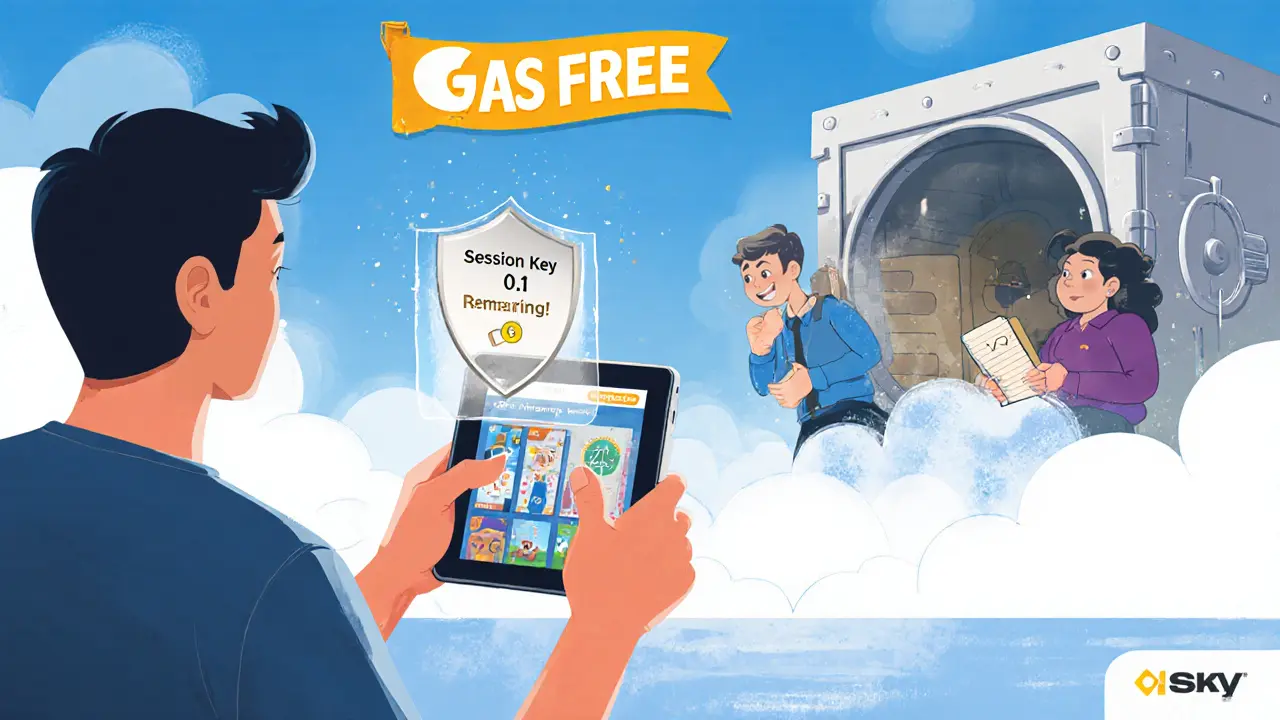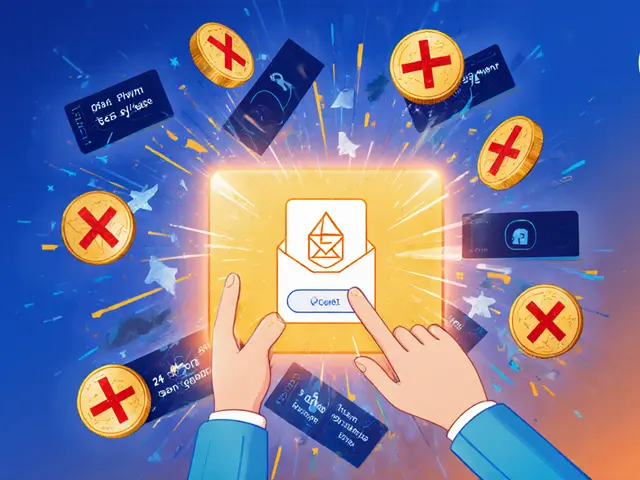Account Abstraction vs Traditional Accounts: The Future of Blockchain Wallets

Gas Fee Calculator: Traditional vs Account Abstraction Wallets
Traditional wallets require ETH to pay gas fees. With account abstraction, you can pay gas fees in USDC, DAI, or other tokens. This calculator shows the cost difference.
Traditional Wallet (ETH Required)
Account Abstraction Wallet (USDC/DAI Accepted)
Why This Matters
With account abstraction, you can send transactions without holding ETH for gas fees. This makes blockchain access more accessible, especially in regions where buying ETH is difficult or expensive. Many wallets like UniPass and Safe already support this feature.
Imagine logging into your crypto wallet with your email instead of a 24-word seed phrase. Or sending a transaction without buying ETH to pay for gas. What if your wallet could lock itself after three failed login attempts, or automatically send funds to a family member if you stop using it for a year? These aren’t sci-fi ideas-they’re real features of account abstraction, and they’re changing how we interact with blockchain.
How Traditional Accounts Work (And Why They’re Broken)
Traditional blockchain accounts, called Externally Owned Accounts (EOAs), are simple by design. They’re controlled by a single private key. That’s it. No passwords. No biometrics. No recovery options. If you lose that key, your money is gone forever. No customer support. No reset button. Just silence. This isn’t hypothetical. In 2024, over $1.2 billion in crypto was lost permanently due to lost or stolen private keys, according to Chainalysis. Most of those losses happened because users didn’t back up their keys properly-or worse, they trusted a centralized service to hold them for them. EOAs also force you to hold native tokens to pay for gas. If you want to swap tokens on Uniswap but don’t have any ETH, you’re stuck. You need to buy ETH first, wait for it to arrive, then proceed. That’s a barrier for new users, especially in regions where buying crypto is hard or expensive. And there’s no flexibility. You can’t set spending limits. You can’t require two people to approve a withdrawal. You can’t auto-pay subscriptions. You can’t revoke access to a dApp without resetting your entire wallet. The system was built for machines, not people.What Is Account Abstraction?
Account abstraction flips this model on its head. Instead of a wallet being a simple key, it becomes a smart contract. Think of it like upgrading from a basic door lock to a smart lock that can let in guests, block strangers, send alerts, and even call a friend if someone tries to break in. The standard that made this possible on Ethereum is ERC-4337. It doesn’t change the blockchain itself. Instead, it adds a new layer on top-a way for smart contracts to act as wallets. These are called Smart Contract Accounts (SCAs). Unlike traditional EOAs, SCAs can run code. That means they can do things like:- Let you pay gas in USDC, DAI, or even tokens from other chains
- Require 2 out of 3 trusted contacts to approve a large transfer
- Recover your wallet using your Gmail or phone number
- Set daily spending limits
- Grant temporary access to a gaming app without giving full control
Key Benefits: Security That Actually Works
The biggest win with account abstraction is security that doesn’t rely on perfect human behavior. Traditional wallets are a single point of failure. One phishing email. One misplaced note. One hacked device-and your life savings vanish. Account abstraction fixes this with programmable safeguards:- Multi-signature approvals: You can require 2 or more people to sign off on any transaction over $1,000. Even if one key is stolen, the thief can’t move funds alone.
- Social recovery: Instead of a seed phrase, you pick 3 friends or family members as “recovery contacts.” If you lose access, they help you reset your wallet. UniPass uses this with email verification, so no one needs to memorize anything.
- Dead man’s switches: If your wallet doesn’t log in for 12 months, it automatically sends all funds to a preset address-like a spouse or charity. No one has to know your private key.
- Session keys: You can give a game dApp permission to spend up to 0.1 ETH over 24 hours. After that, it’s locked out. No risk of long-term access.

User Experience: No More Gas, No More Headaches
The second big win? Usability. Right now, blockchain feels like using a computer in 1995. You need to understand terms like “gas,” “nonce,” and “transaction hash.” You need to juggle multiple wallets. You need to buy ETH just to use a dApp. Account abstraction removes all that. With gasless transactions, you can interact with dApps without holding any ETH. The dApp or a third party pays the gas fee. This is already live on platforms like Sui and zkSync. Users just click “Sign In with Google” and start playing. Wallets become invisible. You don’t think about keys. You don’t think about gas. You just use the app-like you use Instagram or Netflix. This is why companies like Coinmetro call account abstraction “the future of crypto wallets.” It’s not about making crypto more powerful. It’s about making it easier for regular people to use.How It’s Built: ERC-4337 and Beyond
Ethereum’s ERC-4337 is the most widely adopted standard. It doesn’t require a hard fork. Instead, it uses a “bundler” system-a middleman that collects user transactions and submits them as one batch to the blockchain. This keeps things compatible with existing tools like MetaMask. But it’s not perfect. Right now, most ERC-4337 wallets still need an EOA to initiate the first transaction. That’s a temporary workaround. The goal is full independence. Other chains are going further. Sui uses the Move language, where every account is a smart contract by default. No extra layer needed. SKALE offers 700 transactions per second and zero gas fees by redesigning how blocks are processed. And then there’s EIP-3074, which lets EOAs delegate control to smart contracts. It’s a bridge-not the destination. Most developers are moving toward full account abstraction, not hybrid models.Who’s Using It Today?
Account abstraction isn’t just for early adopters anymore.- Safe (Gnosis Safe): Used by DAOs and institutions to manage multi-signature wallets with custom rules.
- UniPass: Lets you sign in with email or Telegram. No seed phrase needed.
- TokenPocket and Coinbase Wallet: Both now support ERC-4337 in beta.
- Sui: Native account abstraction built into the protocol. Users log in with zkLogin (zero-knowledge proofs).
- zkSync: Offers gasless transactions and social recovery for all users.

What’s Still Missing?
Account abstraction isn’t flawless yet. Most wallets still rely on an EOA for setup. That’s a friction point. Developers are working on fully autonomous wallets, but we’re not there. There’s also fragmentation. Different chains implement it differently. What works on Sui doesn’t work on Ethereum without extra layers. And while social recovery is powerful, it introduces new risks. What if your recovery contact gets hacked? What if you pick someone unreliable? These are design challenges-not dealbreakers, but ones that need thoughtful solutions.What’s Next?
The next 12 months will be critical. We’ll see:- More mainstream wallets (like Phantom, Rabby, Argent) adopt ERC-4337
- Mobile apps that let you recover your wallet with Face ID and a text message
- DeFi protocols that auto-reinvest your earnings based on rules you set
- Game studios using session keys to let players spend in-game currency without owning crypto
Should You Switch?
If you’re just holding ETH and sending it to exchanges, you don’t need account abstraction yet. But if you:- Use DeFi or NFTs regularly
- Worry about losing your keys
- Want to give family members access to your wallet
- Get frustrated by gas fees
What’s the difference between a traditional wallet and an account abstraction wallet?
A traditional wallet (EOA) is controlled by a single private key and can’t run code. It can’t recover if you lose your key, can’t pay gas in other tokens, and has no built-in security rules. An account abstraction wallet is a smart contract that can be programmed with custom logic-like multi-sig approvals, social recovery, and gasless transactions.
Do I still need a seed phrase with account abstraction?
Not necessarily. Some wallets like UniPass let you log in with email or social accounts. Others still use seed phrases for backup, but you can set up recovery contacts instead. The goal is to make seed phrases optional, not mandatory.
Can I use account abstraction on any blockchain?
Ethereum and EVM-compatible chains (like Polygon, Arbitrum) support ERC-4337. Sui and Aptos have native account abstraction built in. Bitcoin and Solana don’t yet. But most new chains are planning to add it.
Are account abstraction wallets safe?
They’re often safer than traditional wallets. With multi-sig, recovery contacts, and session keys, you reduce the risk of single-point failures. But like any smart contract, poorly coded wallets can have bugs. Stick to well-audited wallets like Safe or UniPass.
Do I need ETH to use account abstraction?
Not always. With gasless transactions, someone else (like the dApp or a sponsor) can pay your gas fees. You can send transactions in USDC, DAI, or even tokens from other chains. But you may still need ETH for initial setup in some wallets.
Will MetaMask support account abstraction?
Yes. MetaMask is testing ERC-4337 integration and plans to roll it out in 2025. It’s a major shift for them, but they know users need better security and usability.
Is account abstraction only for Ethereum?
No. While ERC-4337 is Ethereum’s standard, other chains like Sui and SKALE have built account abstraction into their core design. Even non-EVM chains are exploring similar models. The trend is global.
